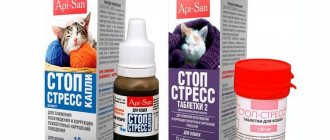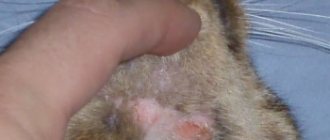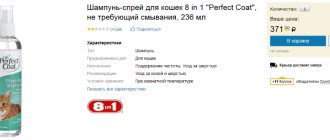Scratching in cats is not considered a big problem, but only until the wounds are bloody or cover a large area. The speed of development of events is also frightening, since most often the cat itches a little, and after 10–12 hours bleeding wounds appear on the pet’s skin. Such a horrifying picture does not pose a serious danger as long as the wounds are not infected. The cat is in pain, nervous, eating poorly, anxious, how can you figure out what to do?
Treating scratches at home
Most often, the owner decides to observe the development of events; in the end, the cat may itch due to nervousness. If the cause is not determined correctly, the situation worsens and scratching becomes painful. The progression of the disease can be determined by the reaction of the animal, which does not allow the scratches to be examined or simply hides.
There is another scenario for the development of events - the external scratching is delayed, and the infection that has “settled” on open wounds goes into the deeper layers of the skin. This happens for two reasons - complete ignorance of the problem or treatment of the animal’s skin at random.
Simply put, when you see a scratch or scratch, you should not smear it with all the ointments that can help; it is better to adhere to the standard treatment regimen or consult a doctor. If abscesses and boils form, you need to consult a doctor, since for recovery you need to remove the infection from the deep layers of the skin as quickly as possible. If the veterinarian doubts that the cat's immune system is functioning at full strength, non-steroidal anti-inflammatory drugs may be prescribed.
Note! Scratching is called a hot spot because the body temperature in the affected areas is usually higher than the base temperature.
If the inflammation does not seem extensive or painful, treatment at home comes down to preventive measures. If you do not allow infection to occur, and the cause of scratching does not lie in illness, the wounds will heal within a few days.
To disinfect and relieve discomfort, wounds are wiped with non-alcohol tincture of calendula. It is best to buy a collection of herbs and make a decoction yourself. If you need to act quickly, and only an alcohol solution is on hand, you need to fill it with hot water or boiling water so that the alcohol evaporates as quickly as possible.
Local discomfort is successfully relieved with cool lotions. For cooling, you can use herbal decoctions - oak bark, calendula, chamomile , etc. You need to be careful with lotions because wounds need to dry out to heal. By the same logic, scratches should not be bandaged or sealed. If the cat actively licks wounds, use an Elizabethan collar or follow the regimen prescribed by the veterinarian.
Note! If a cat has scratches on its head, the use of a collar is mandatory and the main danger is not infection of the wounds, but in causing a traumatic brain injury during scratching with its paws.
If you want to rid your cat of scratching, you need to heal not the wounds, but the reasons for their appearance. The word comb comes from “to itch”, which means that the cat is bothered by itching.
You need to understand that when the skin just itches, the animal does not tear the skin to the point of wounds.
Antihistamines
Antihistamines reversely block H1 receptors in the skin and other organs, thereby reducing itching, erythema and swelling. Antihistamines also have a local anesthetic effect, and many of them cross the blood-brain barrier, producing a sedative effect. The greatest benefit is achieved when the antihistamine is introduced into the body before the release of histamine. Therefore, in animals with chronic itching, it is better to use these drugs for preventive purposes rather than as needed for treatment. Antihistamine therapy is more effective for cats with allergies than for dogs with the condition. It is usually recommended to use antihistamines for 7-21 days.
For itching in cats, the most commonly used antihistamine is chlorpheniramine maleate. In one study (Miller and Scott, 1990), 73% of cats responded excellently to treatment with chlorpheniramine at a dose of 2 mg per cat po every 12 hours. Data on the response of cats to chlorpheniramine treatment differed from those obtained from uncontrolled studies or clinical observations, varying on average from 0 to 73%. The most common dose for cats is 2-4 mg per cat po every 12 hours. In rare cases, 2-4 mg per cat may be given po every 24 hours; treatment every other day is ineffective.
Adverse reactions most commonly encountered when treating cats with chlorpheniramine maleate include temporary drowsiness and hypersalivation when taking the tablet. Occasionally, vomiting, diarrhea and increased excitability are observed. In the United States, chlorpheniramine is available over the counter in tablet form in 4 and 8 mg doses (often labeled) or capsules of similar strengths. To overcome a cat's aversion to the bitter taste of chlorpheniramine, the broken edge of the tablet can be dipped in tuna sauce, oil, or petroleum jelly to mask the bitter taste. You can buy empty gelatin capsules and place the desired part of the tablet in them, or order the drug in a more acceptable form from the pharmacy. Some cats are comfortable with adding 1/4 or 1/2 of the contents of a capsule with chlorpheniramine maleate (8 mg dose per capsule) to their food.
Other antihistamines used in cats include hydroxyzine hydrochloride, clemastine fumarate, cyproheptadine, diphenhydramine, cetirizine and oxatomide (Table 1). Some of these drugs have additional properties, including antiserotonin, which is an antidepressant, a drug with a sedative effect, or a combination of both. Generally, antihistamines are a safe alternative to treatment with glucocorticosteroids or progestogens. The most common side effects include drowsiness and irritability. A cat receiving clemastine fumarate developed periocular erythema. Due to the teratogenic properties of antihistamines, caution should be exercised when treating pregnant cats with them.
| Table 1. Antihistamines used for cats | ||
| Antihistamines | Usual Oral Dose* | Side effects |
| Cetirizine | 5 mg per cat every 12-24 hours 9 mg per cat every 24 hours | Unknown |
| Chlorpheniramine maleate | 2-4 mg per cat every 12-24 hours | Temporary drowsiness Excessive drooling |
| Clemastine fumarate | 0.34-0.68 mg per cat every 12 hours | Lethargy, drowsiness Diarrhea Persistent drug dermatitis |
| Cyproheptadine | 2 mg per cat every 12 hours | Polyphagia Behavioral changes Increased blood urea nitrogen levels |
| Diphenhydramine | 0.5 mg/kg every 12 hours | Increased excitability Excessive drooling |
| Hydroxyzine hydrochloride | 1-2 mg/kg every 8-12 hours 5-10 mg per cat every 8-12 hours | Increased excitability Depression Behavior changes Polydipsia |
| Oxatomide | 30-60 mg every 24 hours | Polyphagia |
| * "per cat" means a medium-sized cat weighing 10 pounds (4.5 kg). | ||
Diagnosis of scratching and itching
Itching is probably one of the most unpleasant sensations that can only be relieved by scratching. It has been proven that a person can become psychotic if they experience itching and cannot scratch themselves. Itching in an animal is a clear sign of skin damage, although it can occur before obvious symptoms appear. In veterinary medicine, as in human medicine, itching is distinguished depending on its nature:
- Localized – one or more specific places are itchy, for example, scratching appears only on the face or on the neck and cheeks.
- Generalized – when the cat’s entire body itches.
Diagnostics
The simplest diagnostic method before going to the vet is using a comb and a piece of paper.
First, the cat's fur needs to be well wetted. After this, the animal is placed on white paper and begins to be combed. A characteristic sign of flea infestation is the appearance of brown droplets on the paper. This color is the color of flea secretions. With extensive damage, living insects can also be seen.
To notice the presence of sores on the skin, you will need to part the fur and examine it with a magnifying glass. You may see brown spots, redness, and flea scratches.
A visit to the veterinarian is required: the doctor will conduct laboratory tests, perform scrapings and blood tests. This will help establish an accurate diagnosis based on the presence of antibodies.
A special allergy test may be required to identify the type of protein to which the animal’s body reacts.
Causes of scratching
The first thing the doctor will do is examine the animal for the presence of parasites. Flea scratches appear all over the body, most often on the cheeks, neck, chin and at the base of the tail. In most cases, even if the animal has recently been treated, parasites are the cause of the itching.
The cat itches because the saliva of blood-sucking parasites always causes an allergic reaction. If you have ever been bitten by a flea or tick, you know that the bite itself is not felt, but afterwards it itches a lot. Flea saliva, injected under the skin, acts as a pain reliever, but since it has a protein base, after some time an allergic reaction occurs.
Note! The development of a flea allergy does not always imply the presence of a large number of parasites; for cats with sensitive skin, a few bites are enough for scratching to appear.
The next most popular reason is microscopic mites. Itching from mites is incomparably stronger than allergic; the area affected directly depends on the method of parasitism. For example, when infected with ear mites, a cat scratches the skin near the ear, forehead and back of the head within 24 hours. The subcutaneous mite can settle on the back, body, under the arms or even on the tail. To confirm or refute the diagnosis, a scraping is taken from the damaged skin for laboratory examination.
During laboratory analysis, scrapings are also checked for the presence of spores, which will indicate a fungal infection of the skin. Cats, dogs and people constantly have fungi and microorganisms living on their skin; not all of them are friendly, but the symbiosis is designed so that the bacteria do not attack the host. When the level of immune defense drops or an active, unfriendly culture is introduced, the cat may develop microsporia, which for many is more commonly called lichen.
Statistically, cats are more likely to get ringworm, but are practically not susceptible to other skin ailments. If the diagnosis is confirmed, the veterinarian will prescribe a course of treatment. Typically, treatment for ringworm involves injections or oral medications. Scratching should be smeared with antiseptic ointments with an antifungal effect.
Important! The symptoms of itching and allergic skin reactions are very similar (redness of the skin, itching, scratching), but are treated differently.
How to choose an effective drug to relieve your cat from itching?
You need to understand that without eliminating the root cause that provokes the appearance of itching on any part of the body, you can use drugs indefinitely. In most cases, medications for itching in cats are prescribed as adjuvant therapy in addition to medications aimed at treating the underlying disease. The following medications are usually prescribed:
Stop-Itching Suspension. It is considered the most effective drug against itching in cats from 8 weeks of age. Produced in Russia by Api-San. Made on the basis of glucocorticoids. Most often prescribed for insect bites, neurodermatitis, food allergies, flea dermatitis and other diseases that cause deep scratching. It is not recommended to use Stop-Itching for demodicosis. The manufacturer also calls for caution when using the drug in pregnant animals and during lactation. As for overdose, the manufacturer refers to a possible overdose and individual sensitivity to one of the components included in the drug. The suspension is administered using a syringe (forcibly) or along with food in the morning.
Stop-Itch Spray. Produced by the same company Api-San. And it is also used for acute allergic reactions complicated by bacterial infection. Refers to broad-spectrum drugs of class 4 (low-hazard drug). The composition includes levomecithin and lidocaine, thanks to which an antibacterial and soothing effect is achieved after spraying on the affected areas of the skin. Excellent for the treatment of otitis media accompanied by severe itching. The manufacturer recommends spraying the spray onto the affected area from a distance of 5-10 cm above the surface of the skin. The bottle must be shaken first. It is better to consult your doctor about the dosage. But, in most cases, spray treatment of problem areas is prescribed twice a day for a week. As contraindications, it is indicated that it is necessary to avoid contact with the eyes and mucous membranes of the mouth. You also need to limit your pet's access to the affected areas (to eliminate the possibility of licking the medicine).
Cytoderm. Another Russian-made drug that copes well with itching in cats of all breeds. CitoDerm is available in shampoo form. The ingredients menthol, aloe vera extract and apple cider vinegar in combination have good soothing and anti-inflammatory properties. Very often, Cystoderm is prescribed as an adjuvant against itching for allergies of unknown etiology, flea dermatitis and psychogenic licking. Use shampoo while bathing, applying evenly to the entire coat, previously moistened with water. After this, the manufacturer recommends holding the animal for a couple of minutes and rinsing off all the product with warm water. Can be used as a preventative to moisturize the skin.
Bifar. A famous Dutch manufacturer that has proven itself to be the best in the veterinary market. Beaphar Shampoo Anti Itch is the best remedy against itching in cats, unless the process is complicated by a bacterial infection. The method of application is the same as for Cytoderm. Contains lemongrass oil and aloe vera extract. Menthol and hypoallergenic sulfur are also present.
All of the drugs listed are excellent for use against itching in a cat if it is caused by an allergic reaction, insect bites, flea dermatitis, or severe stress. Before use, it is recommended to carefully read the instructions and consult a veterinarian.
Allergies as a cause of itching and scratching
If all of the above reasons are excluded, the doctor will assume an allergy.
Food allergies
If you're lucky, the allergy will be food, that is, caused by eating foods or feed that are not entirely suitable for the cat. Food allergies are identified by taking a detailed history. It is important to remember what you fed your ward for the last 10 days, did you change the food, did you treat it from the table, etc. To alleviate the condition, the animal is transferred to a neutral diet and supported with antihistamines. How to recognize allergies in the video below:
Possible reasons
The reasons why a cat scratches its ears are as follows:
- water getting into the ear canal;
- foreign body;
- ear mite;
- otitis;
- anatomical features of the structure of the ear canals;
- bruise, hematoma formation;
- fleas;
- fungal diseases of the skin;
- infectious pathologies of the hearing organs;
- non-compliance with ear hygiene rules, the formation of wax plugs.
The following symptoms indicate pathological changes:
- head tilted to one side;
- the pet itches, tears the skin on the outside near the ear;
- the cat does not allow you to touch the affected area;
- the inside of the ear turns red, plaque and dirt with an unpleasant odor appear on it;
- squelching sound when pressing on the ear.
If the disease is neglected, the animal develops pathology, resulting in a rise in temperature and loss of appetite. The cat becomes restless and shows aggression.
Similar symptoms are observed with the development of the following diseases:
- Otodecosis (scabies caused by ear mites). As the disease develops, an inflammatory process begins, as a result of which the animal develops severe itching.
Otitis. Inflammation of the hearing organs, at the initial stage manifested by itching. Visually, the ears appear dirty and have plaque. The disease can be parasitic, bacterial, mixed.- Allergy. A negative reaction is provoked by allergens that are contained in some food products, hygiene products, household chemicals, and plant pollen.
- Neoplasms (mainly observed in adult animals).
- Notoedrosis. The causative agent of the disease is the sarcoptoid mite, which affects the hearing organs, nasal cavity, and the area above the eyes. The danger of the pathology lies in the fact that as a result of the parasite’s activity, the functioning of the nervous, reticuloendothelial and cardiovascular systems is disrupted.
Stress and mental disorders
It is rare, but it happens that scratching in cats is associated with a mental disorder. Most often, the wounds resemble scratches, but are not them, since the cat is actively licking itself. Wounds form on the paws and shoulder blades. The size and depth of the wounds is rapidly growing, but despite the pain. the cat continues to lick itself.
Assumptions about neurosis are relevant if all of the above reasons could not be confirmed. The diagnosis is confirmed by prescribing a course of sedatives, if the cat begins to actively lick itself and the wounds begin to dry out - the reason is stress.
Why does a cat itch if there are no fleas?
The main cause of cat scratching is fleas. It is because of them that the cat scratches itself until it hurts with sharp claws. The scratches become infected, become inflamed and cause a lot of trouble for the animal. What should you do if a clean and well-groomed pet without fleas continues to itch? The reasons can be completely different.
Cats are known to be clean. They carefully monitor the condition of their fur and do not tolerate dirt on their body. Only a sick cat can look unkempt. The pet always looks good thanks to the efforts of the owner - he is bathed, combed and fed enough.
In some cases, despite seemingly good care, the cat scratches itself until it bleeds and becomes very worried. What can be wrong?
If you are sure that there are no fleas, but the cat continues to scratch its skin, then the reasons may be the following:
- Residual reaction to flea bites. After extermination of fleas, microtraumas remain, which continue to cause itching for some time. If this is the case, then very soon the cat will stop itching.
- Helminths. The cat often licks the anus. It is in this place that the presence of worms causes itching.
- Fungal and bacterial skin lesions. Areas of hair loss can be noticed upon examination. Many of the fungal skin infections, such as microsporia, are contagious to humans and take a very long time to treat.
- External parasites. Fleas, lice, ticks, lice and other blood-sucking insects cause severe itching and irritation in the cat.
- Allergy. Allergic itchy reactions can be caused by a variety of allergens. This could be food, chemicals or medications.
- Hormonal disorders. These types of problems are reflected on the animal's skin. It can become dry, crack at the slightest touch, and cause unbearable itching. Scratching leads to sores in a variety of places.
- Injuries and scratches. A cat can damage the skin and cause infection in the wound. The infected area becomes inflamed, causing discomfort.
In any case, the pet should be shown to a veterinarian. You can only fight fleas on your own using appropriate medications if the cat does not have an allergic reaction.
Small kittens can become infected from their mother, adult cats - when hunting rodents. The waste products of worms inside the body of cats cause intoxication. This affects the health and appearance of animals:
- digestion is disrupted;
- constipation and diarrhea occur;
- the fur becomes dull and brittle;
- the skin becomes dry and flaky, causing itching;
- The anal area itches, and the cat constantly licks it.
Dry skin is the cause of microcracks. Because of the itching, the cat scratches them until they bleed, causing additional injuries. A veterinarian will help you correctly calculate and apply the anthelmintic.
This is a bacterial skin disease. Pustules appear on the animal’s body - blisters with liquid contents. They burst, capturing more and more new areas. After opening, itchy sores form in their place. If the disease is not treated in time, the pet may be left without hair.
Owners often notice that their cat is scratching its neck. Their anxiety intensifies when they see scratches, wounds, or bald patches with lost hair on the neck, behind the ears or under the chin. One question pet owners ask is, “Why is this happening? What to do?" There can be many reasons. Let's look at the main ones.
If an animal begins to scratch the neck area, then this behavior can cause various health problems.
You need to start by checking for fleas. And if insects or their eggs are found, it is necessary to treat with special preparations or bathe with flea shampoo. It must be remembered that even after getting rid of insects, the substance that entered the bloodstream during the bite remains in the body. Its irritating effect can last up to a month and a half, causing the pet to want to scratch its neck until it bleeds.
If fleas are ruled out, then other causes need to be considered, which may include the following:
- skin infections;
- hormonal disorders;
- allergy;
- endocrine disorders;
- lichen;
- psychological problems;
- helminthiases.
Skin infections
Metabolic disorders and a failure in the production of hormones in animals lead to skin disorders, which are manifested by itching. The cat mainly scratches its neck and head, ears, and back. Only a doctor can diagnose the disease and prescribe the correct treatment. Although the diagnosis and treatment of hormonal and endocrine diseases is a complex task and requires long-term treatment. It is advisable to contact specialized clinics that have the necessary equipment for diagnosis.
The most difficult thing to identify is the source of the allergy, which manifests itself as redness of the skin and a red rash. And all these skin problems are accompanied by itching. The cat scratches its neck, wounding itself until it bleeds, given its sharp claws. As in humans, allergies are caused by:
- food (feed);
- house dust;
- houseplants;
- cat litter;
- powders and cleaning products;
- flea collars.
We suggest you read: What helminths (worms) look like in cats
It is very difficult to determine the source that causes the rash. It will take a lot of time and patience to change food, filler, change the environment and observe the animal’s reaction. It must be remembered that even if the source of the allergy is eliminated, the cat’s condition will not improve immediately. The cat can scratch its neck for a long time.
The body needs time to recover from exposure to an allergen. Therefore, food changes are carried out at long (from one week to two) intervals. It is impossible to do without constant monitoring by a veterinarian. And only a doctor can prescribe antihistamines and calculate their dosage.
Be careful! Medicines for humans are not always suitable for cats, and it is impossible to determine the dose yourself.
Varieties of lichens (dermatomycosis) are fungal infections. Ringworm is accompanied by a desire to scratch the neck, hair loss in the affected areas, and is distinguished by sharply defined edges. Only a doctor can determine the type of lichen and prescribe internal and external treatment. Often, dandruff appears on areas of the skin affected by fungi.
Stressful situations associated with moving or the appearance of new family members, both humans and animals, can make a cat want to scratch its neck until it bleeds. If you are sure that your cat is itching until it hurts due to stress, then you can give it special tablets for cats “Cat Bayun”. They are made from herbs and have a mild calming effect. They are used before traveling or other stressful situations.
Helminthiasis
Not all cat owners know that the cause of itching and scratching of the neck can be infection with helminths. Worms disrupt metabolism, which leads to a lack of nutrients in the body of pets. And as a result - dry skin, dandruff and itching. On the other hand, the presence of worms in a cat’s body can cause an allergic reaction, accompanied by a rash and itching. The result is not difficult to predict - the cat scratches its neck until it bleeds.
Infection with worms can occur through:
- raw meat or fish, if given to cats;
- flea bites;
- from cat to kitten.
External parasites
Quite rare, but infection with cheyletiellosis, a separate type of tick, occurs. They settle mainly along the back, and are small white dots that move. Therefore, cheyletiellosis is often called “pityriasis” scabies. The reason that the animal scratches its neck may also be lice, which can be seen in the cat's fur.
Conclusion
As follows from the above, there can be many reasons why a cat constantly scratches its neck until it bleeds, but there are no fleas. And it is almost impossible to independently determine the cause and cure the animal. Only an experienced veterinarian in a clinical setting will be able to:
- identify parasites on the body using a microscope and determine their type;
- do a helminth test;
- diagnose infectious and fungal diseases.
In the absence of parasites and infections, the doctor can do allergy tests for food and filler.
What is important for owners to understand is that if a rash, bloody sores, or bald patches appear on the neck, it is necessary to urgently visit a veterinary clinic. Only a doctor will determine the reason why a cat is scratching its neck and prescribe effective treatment.
The cleanliness of cats, their washing and constant licking of fur have long become a byword. But if your cat is constantly itching and has wounds, then you should pay attention to its health. Why does my cat constantly lick itself and scratch itself?
If a cat constantly licks itself and itches, then there can be many reasons for this state of the animal. They can be divided into the following main groups:
- the presence of parasites and helminths;
- fungal infections;
- reaction to stress;
- allergic reaction;
- hormonal and endocrine disorders.
Skin diseases
The cat is susceptible to a wide variety of skin diseases, the most common of which is pyodermatitis.
This is a secondary infection caused by bacteria that are localized not only in the deep layers of the skin, but also on its surface. A disease called cheyletiellosis, which is a consequence of the appearance of the Cheyletiella mite, also occurs in cats. They live on the cat’s skin and can be seen even with the naked eye. They look like small white spots that move very quickly across the skin.
This article listed the most common causes of itchy skin in animals. In any case, if you notice that your cat is itching until there are sores on its neck, but there are no fleas, you should immediately seek help from a veterinarian. Only a highly qualified specialist will help determine the true reason for this cat behavior.
As a rule, all parasites cause itching, which is the first signal for the owner: something is wrong! But parasites are different. Only a veterinarian can cure your animal; do not prescribe any drugs to your four-legged friend, because they can be toxic to a cat or dog. Together with veterinarian Irina Bolotova, we will talk about the famous “reptiles” that can settle on a pet:
1. Flea
The most common blood-sucking parasite. Lives on both cats and dogs. The danger is in the bite itself. When biting, the flea secretes saliva into the wound, which causes the animal to develop a terrible allergy and severe itching.
How to find out:
The pet is itching. Itching usually occurs on the back, stomach, and back of the thighs. A cat or dog may be walking and suddenly stop and start scratching furiously and biting into the skin. The fur may become bald. If you part the fur, you will see red and black dots all over the spine.
What to do:
Your veterinarian will prescribe special drops for you. You drop them on your pet's withers. And so you will process it 2-3 more times with an interval of 3 weeks. If the itching is severe, then you will be advised to treat the animal once a month prophylactically.
The bedding and rug will need to be washed and ironed. And treat furniture and carpets in the apartment with a special flea spray.
Subcutaneous mite
Bypassing the complex Latin names, let's just say that there are different types of subcutaneous mites:
2. Some are found in the upper layers of the skin and are easily transmitted from animal to animal, that is, they are highly contagious. They are found mainly on the head and ears.
How to find out:
A dog or cat scratches its ears with its hind paw. The tips of the ears often turn red. But only a clinical analysis will show an accurate diagnosis.
What to do:
Treat with drops containing the substance selamectin. Apply to the withers 2 times with an interval of 2 weeks.
3. Another subcutaneous mite that causes demodicosis is found in the deep layers of the skin. Not contagious. The parasite appears on its own as soon as the animal’s immunity weakens. Most often, puppies under one year of age are affected.
How to find out:
The animal itches and often goes bald. But again, it can only be confirmed after testing.
What to do:
You need to consult a veterinarian - perhaps demodicosis will go away on its own as soon as the immune system gets stronger. If treatment is needed, the veterinarian will prescribe ivermectin tablets. (IMPORTANT!!! This drug is dangerous for collie and sheltie dogs). Under no circumstances should you treat an animal for demodicosis yourself; consult a veterinarian.
4. Ear mites
It causes otodectosis - ear scabies. The disease is contagious to cats and dogs.
How to find out:
Severe itching in the ears. If you look into the ear, you will see dark crusts there.
What to do:
Drops are needed to treat the animal's withers.
5. Lice eaters (trichodectosis)
Small wingless parasites look like fleas. They crawl on fur and are easily transmitted from animal to animal.
How to find out:
Severe itching, scratching, hair loss all over the body.
What to do:
Show it to a veterinarian to determine the diagnosis. The doctor will prescribe drops on the withers, which you will use to treat your pet.
It is quite difficult to recognize the early signs of any disease in animals, because apart from restless behavior, no deviations may be observed. Even if the pet begins to itch, bite itself and roll on the floor, then with a 90% probability the owner will attribute this to the presence of parasitic insects. But it happens that the cat is constantly itching and licking, but there are no fleas. How to determine the true cause of an animal's anxiety?
The cat scratches its neck until it hurts - accompanying symptoms
The sore due to allergies was strongly scratched by the cat.
Allergies in animals are caused by various irritants:
- food;
- elements of the external environment (pollen, dust, mold);
- medicines;
- saliva of blood-sucking insects, such as fleas;
- hygiene products.
It is important to determine what exactly causes the cat's allergies. For proper treatment, it is necessary to exclude the animal from contact with the substance that causes the painful condition. Allergies are treated with antihistamines. The dose is prescribed by the veterinarian.
Attention! It is important to know that if a cat has fleas, the animal is treated with special means. For example, insecticidal drops are applied to the animal’s withers.
Follicle
Follicle.
Follicle is a disease that occurs as a result of staphylococcus damage to the animal’s body. It is treated with antibiotics and immunostimulating drugs.
Eczema is a skin disease that develops due to stress, infectious diseases, and diseases of internal organs.
Eczema.
An exacerbation of this disease occurs in the autumn and spring periods. The disease is treated comprehensively: medicated shampoos, protection from stress, immunostimulating drugs, vitamins, and a balanced diet.
A sore that forms on a cat’s chin, more often a scattering of small black dots (acne) mixed with sores and ulcers, is called acne. It develops as a result of poor nutrition, skin irritation from contact with unsuitable utensils (reaction to plastic), and skin infections.
Sores with an odor in a cat are localized in the ears and are a consequence of advanced infection with ear mites. When the ears are not properly cared for, there is a high risk of otitis of various etiologies; the cat scratches the itchy ears until foul-smelling wounds do not heal.
Eye sores that appear in a cat may indicate the presence of a viral infection, injury to the cornea of the eye, a foreign body or an allergy. The irritating factor causes itching in the cat, the animal scratches the skin until sores appear.
Sores on a cat's head can appear as a result of damage in fights or games with another animal. A sore found on a cat’s nose can also be the result of injury, an allergic reaction, polyposis, or a viral infection. If, with proper sanitation, the cat’s sore does not go away within three days, you need to show the animal to a specialist.
We invite you to familiarize yourself with: Smoke bomb against insects for the home: buy in Moscow, St. Petersburg for residential premises
Sores found on the side of the cat's tail are most likely due to hyperplasia of the sebaceous caudal glands. Increased secretion production clogs skin pores, causing irritation. Sores on a cat’s tail are the animal’s reaction to itching, scratching and hair loss with the formation of crusts on the scratched areas.
Detected sores on a cat’s fur should serve as a signal to contact a veterinarian as soon as possible to determine the cause. If desired, a specialist can be called to your home for an initial diagnosis of the disease and to take the necessary tests from the animal. Unnecessary worries will not improve the health of a sick pet, and at home, both the cat and the owner are less stressed.
Skin diseases in cats are at the forefront of modern veterinary medicine. This is due to poor nutrition - poorly selected feed, illiterate breeding work, and poor environmental conditions play an important role. Due to the above factors, local or widespread rashes, ulcers, etc. may appear on the skin. Below are all the skin lesions of cats, grouped into groups according to clinical symptom complexes.
Miliary dermatitis is characterized by the formation of dry or weeping, cavity-free elements on the skin. They are located on the surface in the form of small elevations, form crusts or peel off, fester or are presented in the form of small nodules. Miliary dermatitis covers most of all skin diseases and can be caused by the following reasons.
Allergies to food, hygiene products or medications.
Damage to the skin by a fungal or bacterial infection.
Atopic dermatitis.
Upon examination, blood-sucking ticks, fleas and cheylitelas will be noticeable. Cheylitelas are also called “creeping dandruff”, as they look like small, gray, constantly moving scales.
If the results of the above diagnostic measures are negative, it is recommended to examine the stool for worm eggs. Helminths can cause allergic miliary dermatitis.
Characterized by the presence of alopecia (baldness). On hairless areas, hard-to-remove white or pale gray scales form, under which hyperemic, thinned skin is revealed. The presence of itching and its intensity depend on the type of pathogen and the degree of damage.
It is also advisable to treat a fungal infection on the recommendation of a veterinarian. Depending on the strain of the fungus and the degree of damage, only light local treatment or long-term complex treatment with additional vaccination may be needed. It is not recommended to prescribe antifungal drugs or hygiene products with an antimycotic effect on your own. Many of them are toxic, and certain breeds of cats are especially susceptible to them.
Suppuration of existing wound surfaces, scratches, and folds occurs. Bubbles, crusts, pustules or scales form at the site of the lesion. As a rule, the process affects only the superficial layers of the skin; deeper lesions should suggest more serious conditions (decreased immunity, use of glucocorticoids, neoplasms, viral infection).
Caused by foods, certain plants, medications, or the sun. It manifests itself as itching and rashes in the muzzle, on the tips of the ears, along the lower edge of the eyelid or in the area of the nose and lips. Hairless areas appear on the sides and stomach.
As a rule, the disease occurs annually, at the same time, gradually progressing. Without treatment over several years it leads to squamous cell skin cancer.
Similar to allergies, but more severe and more acute. Appears as a pathological reaction to ordinary products and agents that, in principle, are not allergens.
Alopecia can be either an independent disease or a symptom of other common diseases among cats. It can be congenital or acquired. Congenital alopecia and hereditary hypotrichosis are manifested by an abnormally low number of hair follicles. This occurs only in certain breeds - sphinxes, Devon rexes, etc.
Acquired alopecia includes seasonal molting, complications of miliary dermatitis, traumatic and psychogenic alopecia. With psychogenic baldness, a cat, due to a behavioral disorder, plucks or intensively licks its fur. Traumatic alopecia forms at the site of injections, collars or other injuries.
Endocrine alopecia is also distinguished - it is symmetrical on both sides of the body, and can be caused by disorders in any of the endocrine organs.
Albinism is a birth defect. It is not subject to treatment, and the animal is not allowed for breeding.
Periocular leukotrichia. Develops as a result of stressful situations in some breeds. It manifests itself as lightening of the fur around the eyes. It does not require treatment and goes away on its own.
Lentigo. These are dark spots that appear on the gums, nose, lips or eyelids. There is no cure. The disease is not dangerous and is only a cosmetic problem.
Tumors
Skin tumors can be either benign or malignant. This is difficult to determine visually even for a veterinarian, so any tumor in your cat requires additional examination. The sooner this is done, the greater the likelihood of a successful outcome.
Panniculitis is an inflammation of subcutaneous fat. It is characterized by the appearance of bubbles with liquid in the lower part of the chest or symmetrically on the sides. After some time, the blisters open and form ulcers with oily contents. Ulcers do not heal for a long time; deep scars remain in their place.
Acne - comedones. They arise as a result of disruption of the sebaceous glands. Rashes appear on the cat's face. Acne can become inflamed due to a bacterial infection.
Seborrhea. It can be dry and oily. Dry seborrhea is dry white scales that appear on dry, thin skin. It is most often the result of stress and can occur within a few hours. Oily seborrhea is the same as scales only on oily skin and hair. It is the result of a disruption in the functioning of internal organs, most often the liver and pancreas.
Inflammation of the perianal glands. Occurs rarely. You can suspect it if the cat constantly licks and scratches the anus, and defecation gives her pain and discomfort.
Hyperplasia of the tail glands. The waxy secretion of the sebaceous glands accumulates in the upper part of the tail, where there are especially many of them. The base of the tail thickens, and an oily secretion of gray-yellow color is released. The coat becomes thin and dull.
We suggest you read: Tapeworms in humans: symptoms and treatment
Any skin disease in a cat requires adequate diagnosis and treatment. After all, they can signal more serious violations. There is no need to treat abrasions and scratches; cats themselves lick such damage. damage
Recently, skin diseases have become widespread in cats, from which, according to statistics, every third pet suffers. Often, problems with the skin are the result of some internal pathology that requires immediate treatment. Many skin diseases pose a danger not only to the cat, but also to the owner, so it is extremely important to promptly recognize the disorder and begin treatment.
There is a whole spectrum of skin diseases that are diverse in nature and manifest themselves in completely different ways. Skin lesions can be caused by a variety of reasons - hereditary, anthropogenic, infectious; even a simple change in diet can cause rashes on the body.
Attention. We should not forget that fleas are carriers of helminths and can infect an animal through a regular bite. Therefore, along with treatment for fleas, the animal should be dewormed in a timely manner.











